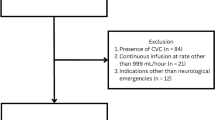Summary
Neurocritical care of ischemic stroke is warranted in case of 1) space-occupying middle cerebral artery (MCA), hemispheric, or cerebellar infarction, 2) Occlusion of basilar artery or bilateral vertebral arteries, 3) compromised vital functions, 4) severe medical complications, or 5) interventional therapeutic approach. Space-occupying MCA infarcts result in progressive brain edema leading to death due to herniation in about 80% of patients. Medical (e.g., osmotherapy) and physical measures only transiently lower intracranial pressure (ICP). Early hemicraniectomy lowers mortality below 40% but functional outcome is frequently unsatisfactory, especially in older patients. Moderate hypothermia can lower ICP. Its effect on survival rate and quality of life, however, needs further evaluation. Intraarterial thrombolysis is the decisive therapy in basilar artery occlusion. Intensive care aims at securing vital functions and hemodynamic stabilization. Space-occupying cerebellar infarction lead to gradual deterioration of alertness, brain stem compression, and occlusive hydrocephalus. Depending on the clinical state, the stratified therapeutic approach consists of clinical-neuroradiological-neurophysiological monitoring, external ventricul drainage (EVD) or suboccipital decompressive surgery plus EVD.
Zusammenfassung
Die intensivmedizinische Therapie von ischämischen Schlaganfällen ist indiziert bei: 1. Raumfordernder Wirkung großer Media- oder Hemisphäreninfarkte und Kleinhirninfarkten 2. Verschluss der A. basilaris oder beider Vertebralarterien 3. Beeinträchtigungen der Vitalfunktionen 4. Schweren internistischen Komplikationen 5. Durchführung interventioneller therapeutischer Maßnahmen. Raumfordernde Mediainfarkte führen zu einer über 72h progredienten Hirnschwellung, die in bis zu 80% der Patienten zum Tod durch Herniation führt. Medikamentöse (z.B. Osmotherapeutika) oder physikalische Maßnahmen können den intrakraniellen Druck (ICP) nur vorübergehend senken. Die frühe Hemikraniektomie senkt die Mortalität auf unter 40%, das funktionelle outcome ist jedoch besonders bei älteren Patienten häufig nicht befriedigend. Die moderate Hypothermie kann zwar den ICP senken, ihr Effekt auf Überlebensrate und -qualität bedarf jedoch weiterer Evaluation. Die intraarterielle Thrombolyse ist die entscheidende Therapie bei Basilarisverschluss. Intensivmedizinische Aufgabe ist die hämodynamische Stabilisation und die Sicherung der Vitalfunktionen. Raumfordernde Kleinhirninfarkte führen zu einer allmählichen Vigilanzminderung, Hirnstammkompressionszeichen und Verschluss-hydrozephalus. Das therapeutische Vorgehen wird abhängig vom klinischen Zustand stratifiziert: klinisch-neuroradiologisch-neurophysiologisches Monitoring, alleinige externe Ventrikeldrainage (EVD) oder subokzipitale Dekompression plus EVD.
Similar content being viewed by others
Author information
Authors and Affiliations
Additional information
Eingegangen: 28. Juli 2001 Akzeptiert: 12. November 2001
Rights and permissions
About this article
Cite this article
Veltkamp, R., Röttger, C. & Schwarz, S. Intensivmedizinische Therapie des Ischämischen Schlaganfalls. Intensivmed 39, 221–232 (2002). https://doi.org/10.1007/s003900200031
Published:
Issue Date:
DOI: https://doi.org/10.1007/s003900200031




